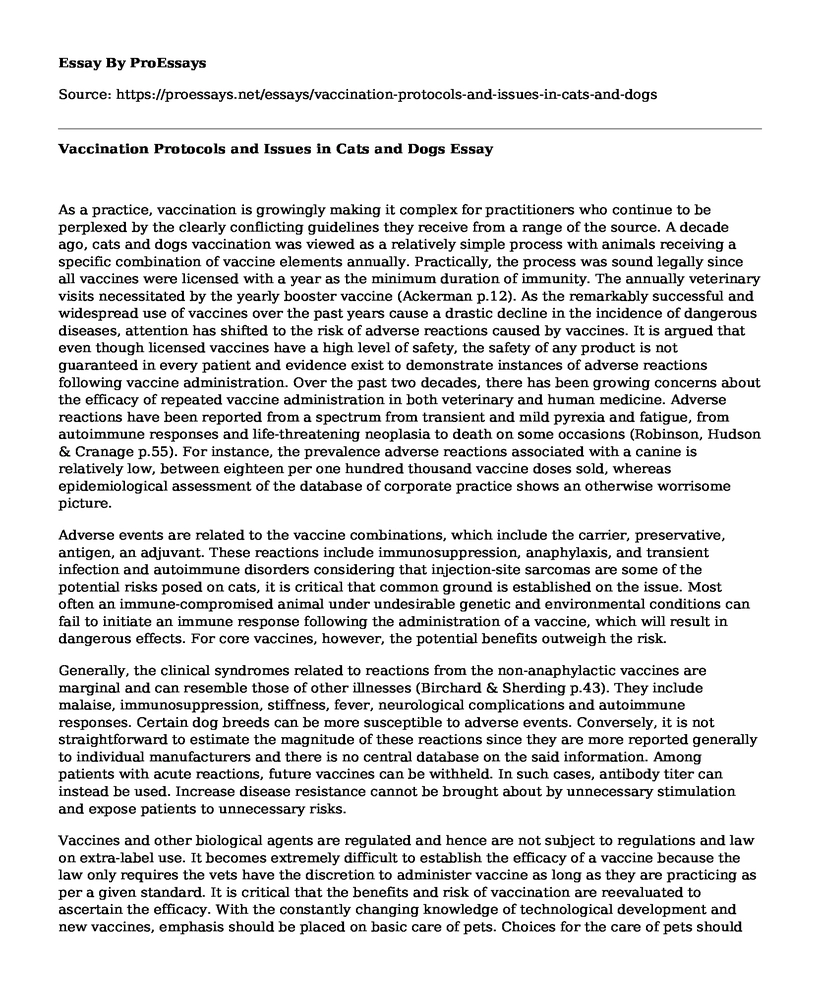As a practice, vaccination is growingly making it complex for practitioners who continue to be perplexed by the clearly conflicting guidelines they receive from a range of the source. A decade ago, cats and dogs vaccination was viewed as a relatively simple process with animals receiving a specific combination of vaccine elements annually. Practically, the process was sound legally since all vaccines were licensed with a year as the minimum duration of immunity. The annually veterinary visits necessitated by the yearly booster vaccine (Ackerman p.12). As the remarkably successful and widespread use of vaccines over the past years cause a drastic decline in the incidence of dangerous diseases, attention has shifted to the risk of adverse reactions caused by vaccines. It is argued that even though licensed vaccines have a high level of safety, the safety of any product is not guaranteed in every patient and evidence exist to demonstrate instances of adverse reactions following vaccine administration. Over the past two decades, there has been growing concerns about the efficacy of repeated vaccine administration in both veterinary and human medicine. Adverse reactions have been reported from a spectrum from transient and mild pyrexia and fatigue, from autoimmune responses and life-threatening neoplasia to death on some occasions (Robinson, Hudson & Cranage p.55). For instance, the prevalence adverse reactions associated with a canine is relatively low, between eighteen per one hundred thousand vaccine doses sold, whereas epidemiological assessment of the database of corporate practice shows an otherwise worrisome picture.
Adverse events are related to the vaccine combinations, which include the carrier, preservative, antigen, an adjuvant. These reactions include immunosuppression, anaphylaxis, and transient infection and autoimmune disorders considering that injection-site sarcomas are some of the potential risks posed on cats, it is critical that common ground is established on the issue. Most often an immune-compromised animal under undesirable genetic and environmental conditions can fail to initiate an immune response following the administration of a vaccine, which will result in dangerous effects. For core vaccines, however, the potential benefits outweigh the risk.
Generally, the clinical syndromes related to reactions from the non-anaphylactic vaccines are marginal and can resemble those of other illnesses (Birchard & Sherding p.43). They include malaise, immunosuppression, stiffness, fever, neurological complications and autoimmune responses. Certain dog breeds can be more susceptible to adverse events. Conversely, it is not straightforward to estimate the magnitude of these reactions since they are more reported generally to individual manufacturers and there is no central database on the said information. Among patients with acute reactions, future vaccines can be withheld. In such cases, antibody titer can instead be used. Increase disease resistance cannot be brought about by unnecessary stimulation and expose patients to unnecessary risks.
Vaccines and other biological agents are regulated and hence are not subject to regulations and law on extra-label use. It becomes extremely difficult to establish the efficacy of a vaccine because the law only requires the vets have the discretion to administer vaccine as long as they are practicing as per a given standard. It is critical that the benefits and risk of vaccination are reevaluated to ascertain the efficacy. With the constantly changing knowledge of technological development and new vaccines, emphasis should be placed on basic care of pets. Choices for the care of pets should be examined, and the evidence-based medicine should take center stage when weighing such options to ensure optimum benefit for all stakeholders.Works Cited
Ackerman, Lowell. Blackwell's Five-Minute Veterinary Practice Management Consult. Ames, Iowa: Blackwell Pub, 2007.
Birchard, Stephen J, and Robert G. Sherding. Saunders Manual of Small Animal Practice - E-Book., 2005.
Robinson, Andrew, Michael J. Hudson, and Martin P. Cranage. Vaccine Protocols. Totowa, N.J: Humana Press, 2003.
Cite this page
Vaccination Protocols and Issues in Cats and Dogs. (2022, Feb 28). Retrieved from https://proessays.net/essays/vaccination-protocols-and-issues-in-cats-and-dogs
If you are the original author of this essay and no longer wish to have it published on the ProEssays website, please click below to request its removal:
- Lymphedema Treatment Research Paper
- Parkinson's Disease Essay
- Robert Wood Johnson Foundation Committee Initiative on the Future of Nursing and IOM
- Research Paper on Respiratory Diseases in Older Adults
- Community Healthcare Issues Paper Example
- Essay Sample on Cardiovascular Illness
- NHS Smoke-Free Health Harm Campaign: Unfavorable Health Effects of Tobacco - Essay Sample







